Blog
Blog
Coming soon.
Blog
DB on Buying Technology
Through the years, I’ve purchased a lot of technology for our companies and for myself. By technology, I am broadly using the term for the software and/or hardware we use. While I’m a big believer in the power of technology, in my experience, technology buying, especially for companies, can be confusing, resource-consuming, and even disappointing. It’s not uncommon to be excited about a solution only to be disappointed after purchasing it. It happens so often that there’s a name for it: Gartner Hype Cycle.
The Gartner Hype Cycle is a chart that shows the stages a tech buyer goes through, specifically:
- Technology Trigger
- Peak of Inflated Expectations
- Trough of Disillusionment
- Slope of Enlightenment
- Plateau of Productivity
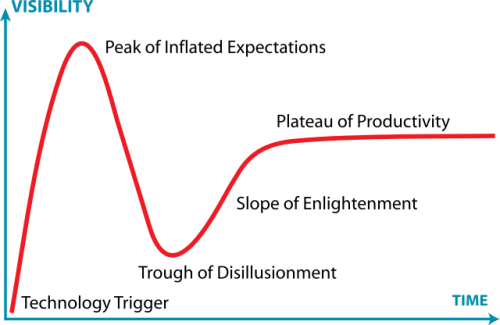
You can learn more about each stage in this article, but I want to focus on 3 things that have helped our companies manage the trough of disillusionment and move towards enlightenment and productivity. (Keep in mind that I’m looking at this from the perspective of a small to medium business. Enterprise-level companies may have more sophisticated requirements.) Here are my three pieces of advice:
- Look for a Solution (not a collection of features)
- Choose a Partner not a Vendor
- Make a Plan not just a Purchase
Look for a Focused Solution
This is counterintuitive to most buyers. It’s easy to think that a “better deal” is the one that gives us the most features for the least amount of cost. But this is like buying something we don’t need on sale and thinking we got saved money. The reality is this: we don’t save any money from purchasing things we don’t need, even if we acquired it cheaply. The goal of purchasing technology or a technology service is to help us solve a problem or improve a process. Sometimes, actually many times, what gets in the way of choosing the best solution for our requirements are the bells and whistles we don’t actually need. To put this simply: we are easily distracted from our need-to-haves by our nice-to-haves. Instead, I recommend following this process:
- Focus on Your Most Important Need(s): Why am I purchasing this? What problem do I need to solve? What risk do I need to mitigate? What process do I want to optimize?
- Choose According to Your Most Important Needs: Which solution addresses my priority needs?
Choose a Partner not a Vendor
The Gartner Hype Cycle explains that there is almost always a period where expectations and delivery need to be calibrated. During this phase, it’s common to think that we’re not getting what we were promised. This is when it is important that we are working with a partner not just a vendor. A vendor is simply out to sell you something, while a partner is out to create value together. Because technology purchases need calibration, it is inevitable that extra work is necessary to fully enjoy the promise of the solution. This is why choosing a partner, someone who you can trust and work with well, is incredibly important. A partner will journey with you through each phase, reassuring you by their responsiveness and expertise that the implementation and operation is going well.
Make a Plan not a Purchase
This is something many technology buyers fail to do when shopping for technology. Ultimately, the benefits of technology are only felt if the solution that is chosen is practicable. We will not enjoy the benefits of high-tech things if we’re not able to apply them to our workflows. So it’s important to have a plan for the purchase and implementation, but also how we’re going to improve user adoption and mastery. This is another reason why #2 (Choose a Partner not a Vendor) is very valuable. Having a plan and partner beyond the purchase and implementation helps you with adoption and mastery. This way, not only do you get past the Trough of Disillusionment you are able to achieve Enlightenment, which is just a fancy way of saying you’re now able to use the technology better.
Final Thoughts
I hope these three pieces of advice help you with your next tech purchase. Happy to answer any questions you may have about purchasing technology for your business. Feel free to email me at david@bridgesoutheast.
For our clients at PayDay, we have focused on providing them Accurate, Secure, On-Time Payroll Processing. We do our best stay focused on those three things. Clients who choose us have identified that accuracy, security, and timeliness are the most important factors for their payroll requirements. That’s the solution we offer.
PayDay clients get both the technology (payroll platforms) and a PayDay Partner, someone to guide them through adoption and mastery. This is part of our commitment to clients to help them enjoy Accurate, Secure, On-Time Payroll.
Finally, PayDay Partners work with clients to solve payroll concerns and see how they can work together to improve payroll accuracy, security, and timeliness.
About the Author
David Bonifacio is the CEO of Bridge, a Philippine venture builder focused on the future of work. David also serves as a Director in Bonifacio One and as a Venture Partner in TNB Aura.
Access LEAP For Your LGU
When COVID-19 hit the Philippines and there was a rise in positive cases, Enhanced Community Quarantine (ECQ) was implemented in Metro Manila and different parts of the country. Various areas of society suffered the blow brought about by the pandemic. Many Filipinos have already suffered massive damage to their capacity to make a living and despite the easing of quarantine measures, thereby allowing more businesses to reopen, more workers are still in danger of having their livelihood destroyed by this pandemic.
Local Government Units (LGUs) initially focused most of their time and resources on providing solutions to the health issues of their constituents. Support for the health sector was of primary concern. However, the need to address the issue of losing one’s livelihood and providing assistance to those affected, still needed to be addressed.

With this in mind, our team at Bridge Access came up with Access LEAP. LEAP is short for Local Economic Assistance Platform. Essentially, LEAP activates the private sector to get involved in rebuilding the community that was severely affected by the COVID-19 pandemic.
Access LEAP provides data-driven economic solutions such as micro financing, corporate assistance, and social services using a technology-powered platform that triggers the partnership between LGUs and the private sector within their respective communities.
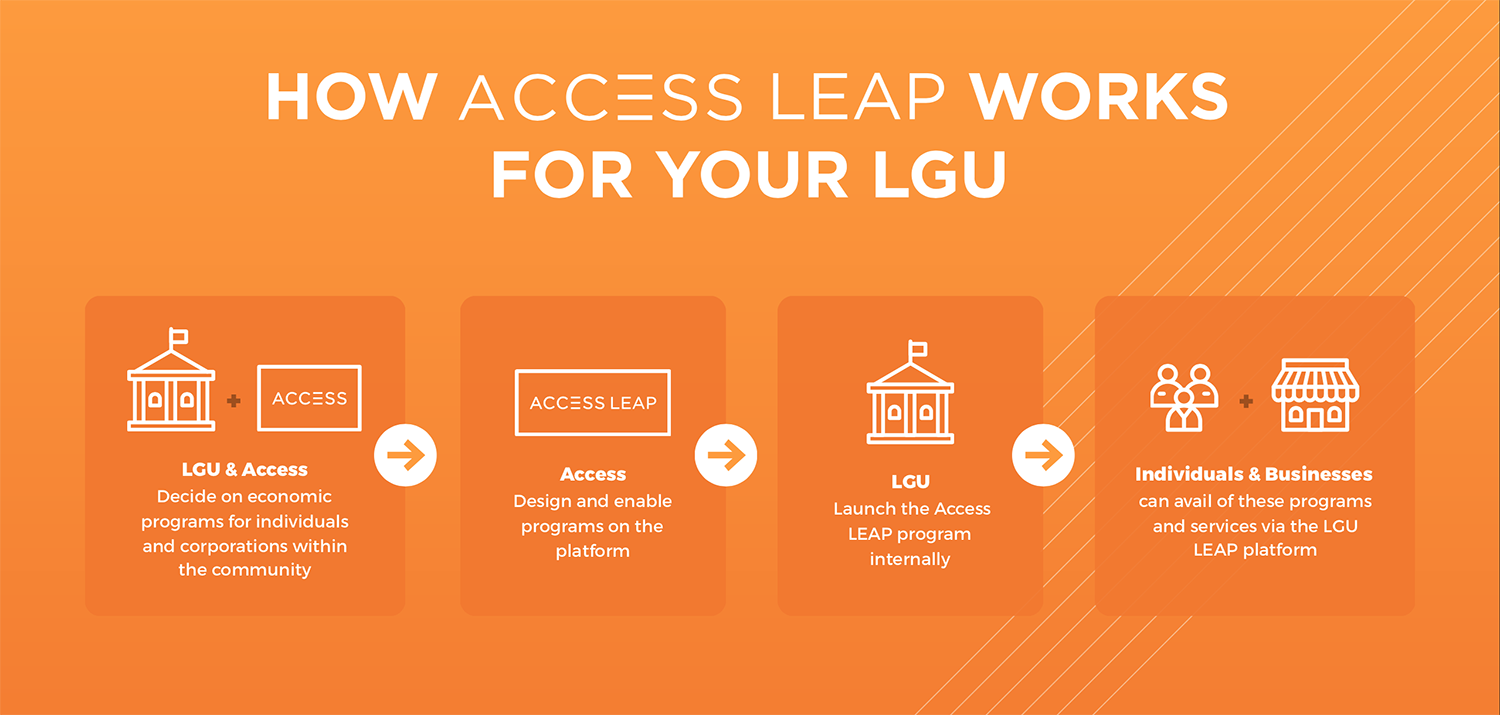
One example of this is Pasig TAPAT which, since its launch in July 10, has already helped 7,000 applications of over 15,000 users to access Php 60,000,000 worth of micro loans in less than a week.
Bridge Access exists to sustainably secure access to livelihood. We seek to partner with people to help stabilize and secure their livelihood in order to provide for the basic necessities of their family. As they are able to do this, we also assist them in reaching their financial goals by helping them save in many different ways.
If you would like Access LEAP to partner with your community or would like more information on the LEAP programs, you can reach out to access@bridgesoutheast.com.
The New Normal: Our 1-Page Active Response Plan
I’d like to share our team’s very simple approach tackling the challenges the Coronavirus has brought about. We have purposefully kept it simple and focused because of the time, money, and energy constraints we and many businesses are facing during this period. I, personally, dislike unnecessary complexity. While I don’t think anyone would ever admit to liking “complexities”, somehow the plans, strategies, and approaches of well-meaning managers are full of them. In extra volatile times, it’s important that we don’t complicate our actions, but try to be as clear, competent, and committed as possible. It’s easier to understand, commit to, and execute a simple plan. While a complex plan might seem impressive, for limited companies like our’s would have a hard time bringing that plan to reality. So here’s our 1-Page template for planning a response.
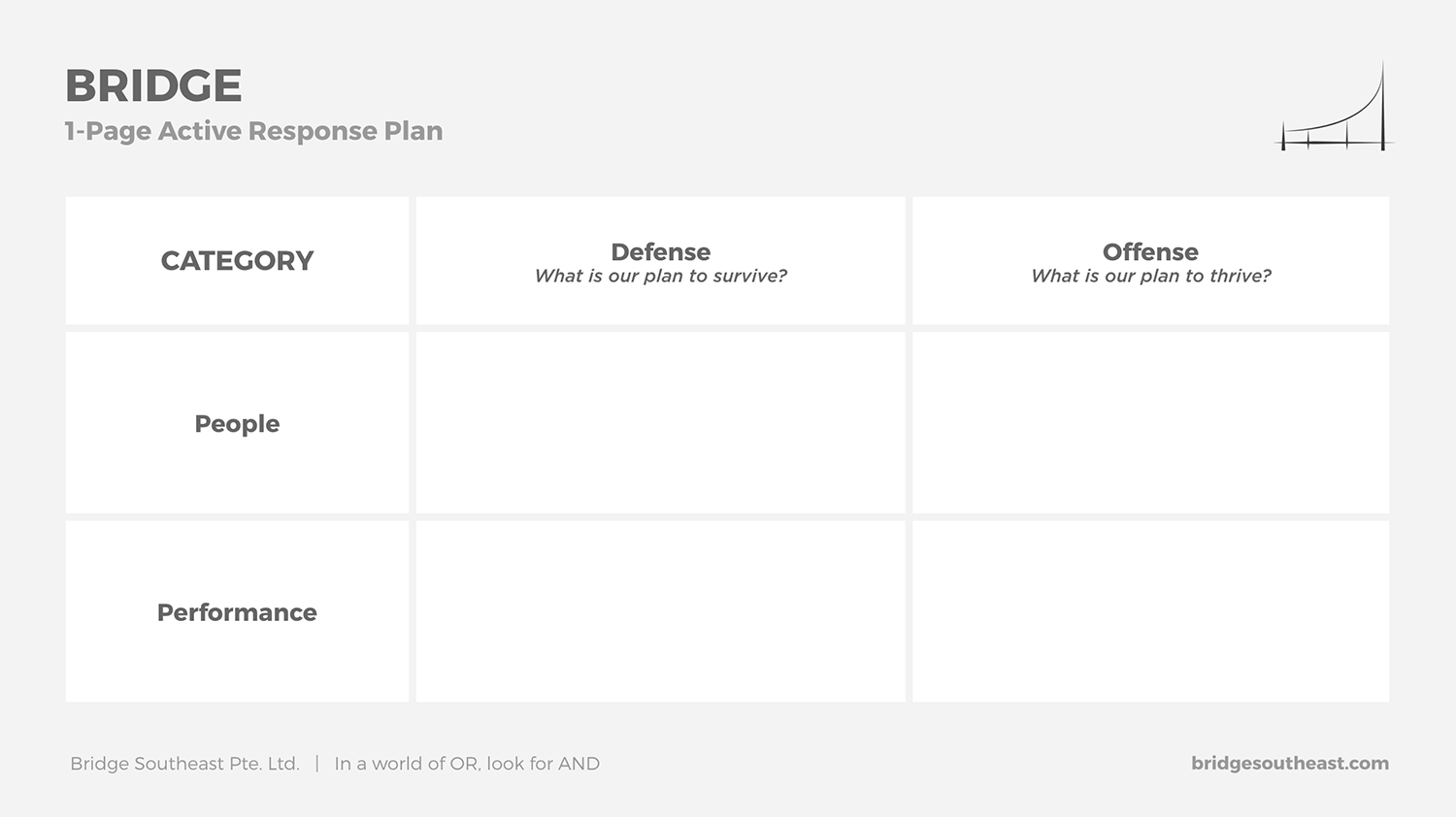
As you can see, it’s more a framework than an actual plan. In the first column are our two priorities: Our People and Performance. The second column is the Defense column. Here we ask, What is our plan to survive? How do we protect our people and performance from the effects of the Coronavirus? The 3rd column is our Offense column, where we ask, What is our plan to thrive? We want to make sure that, even as we’re acting as prudent as possible given the threats we’re facing, we are still thinking about our core purpose for existing as a business. We don’t start companies simply to survive hard times but to Create and Capture Massive Value. Our Offense column makes sure that we have a plan to continue doing those two things despite the difficulties.
I’m extremely fortunate to have very strong leaders in Eric Wong (COO of Bridge), Junnie Lopez (CEO of Bridge People Solutions), and Janna De Guzman (CEO of Bridge Access), so I focus mostly on coaching them and guiding our strategic frameworks more than simply deciding for the team and ordering them around. As has been said, over and over, why “Why hire really smart people and not make them think by telling them what to do?” I know I give up a lot of control with my style of management, but my goal isn’t control, it’s success, and I find that empowering the people who are closest to the customers to influence and execute strategy works better in the long run than a single person expected to be omniscient, or worse, thinks he or she is omniscient. So when discussing this framework with our team, I asked them individually and as a group for their feedback, and that influenced our final “plan”.
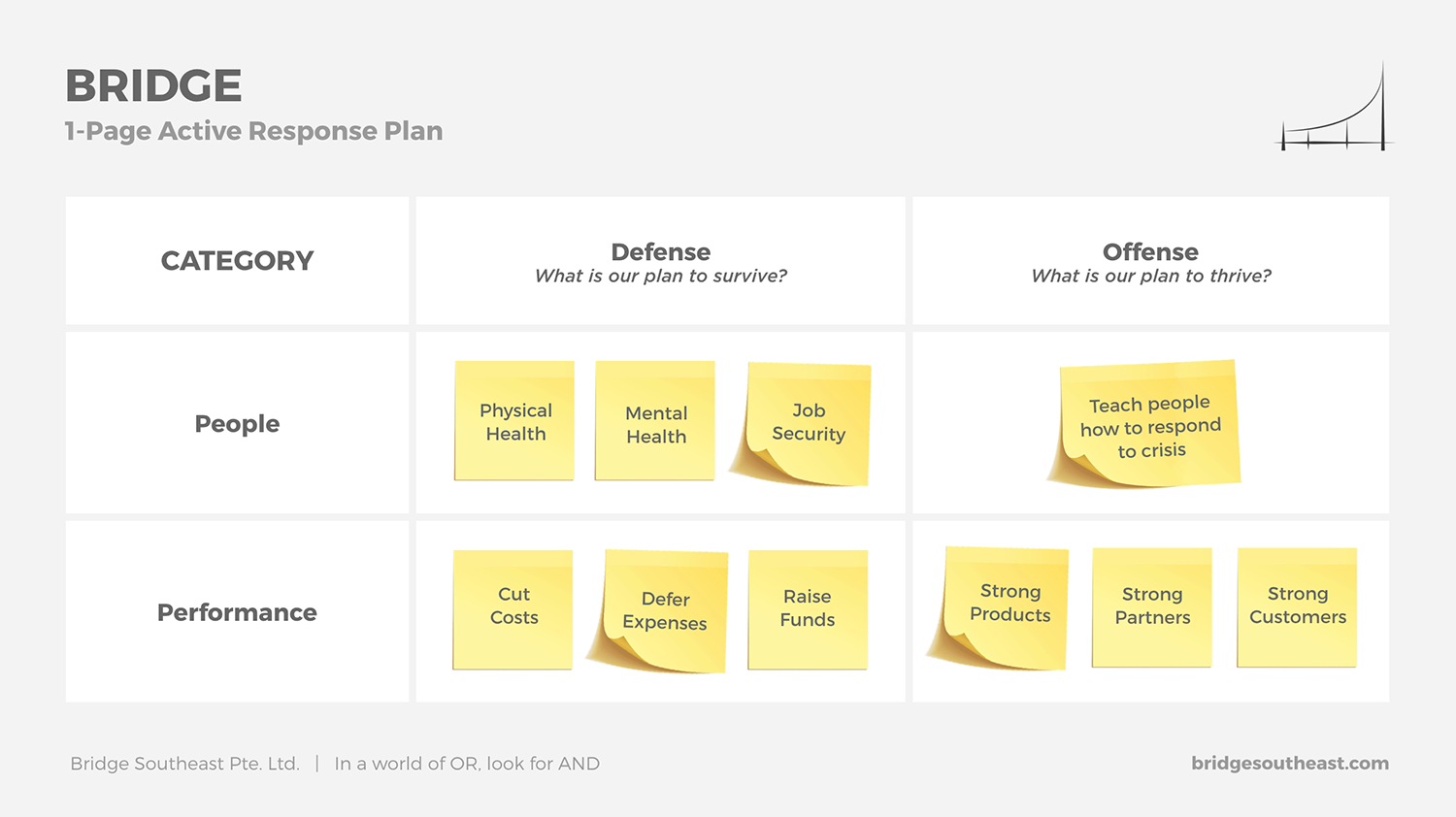
Here’s what a basic plan looks like for us. I’ve already mentioned that we are a startup. So this means we have the resource limitations that are common to early stage companies and have to plan accordingly. This means that most of the activities we are doing must not eat up a lot of resources. If you look at your People row, you’ll find that our efforts are not around bailouts or insurance plans but more “education”. I believe that the number one benefit startups offer is a high rate of learning, including a high rate of personal learning. The leaders and I spoke about what we can offer, and we zoomed in on making sure our people are staying physically healthy, mentally healthy, and have as much job security as possible. For offense, for moving forward, we’re focused on helping teach our people how to grow into workers who are not paralyzed by the circumstances.
A lot of the Performance items are things you would expect in a standard crisis plan. I kept it quite general since the specifics are in the more details version of this framework for each subsidiary. Janna and Junnie take these themes and work on specific action plans that fit their context.
Here’s a little more detail. The yellow “post-its” are the priorities and the different colored ones are more actions items. It’s important that our plans are as actionable as possible. We then assign these action items to the right people (or to multiple people).
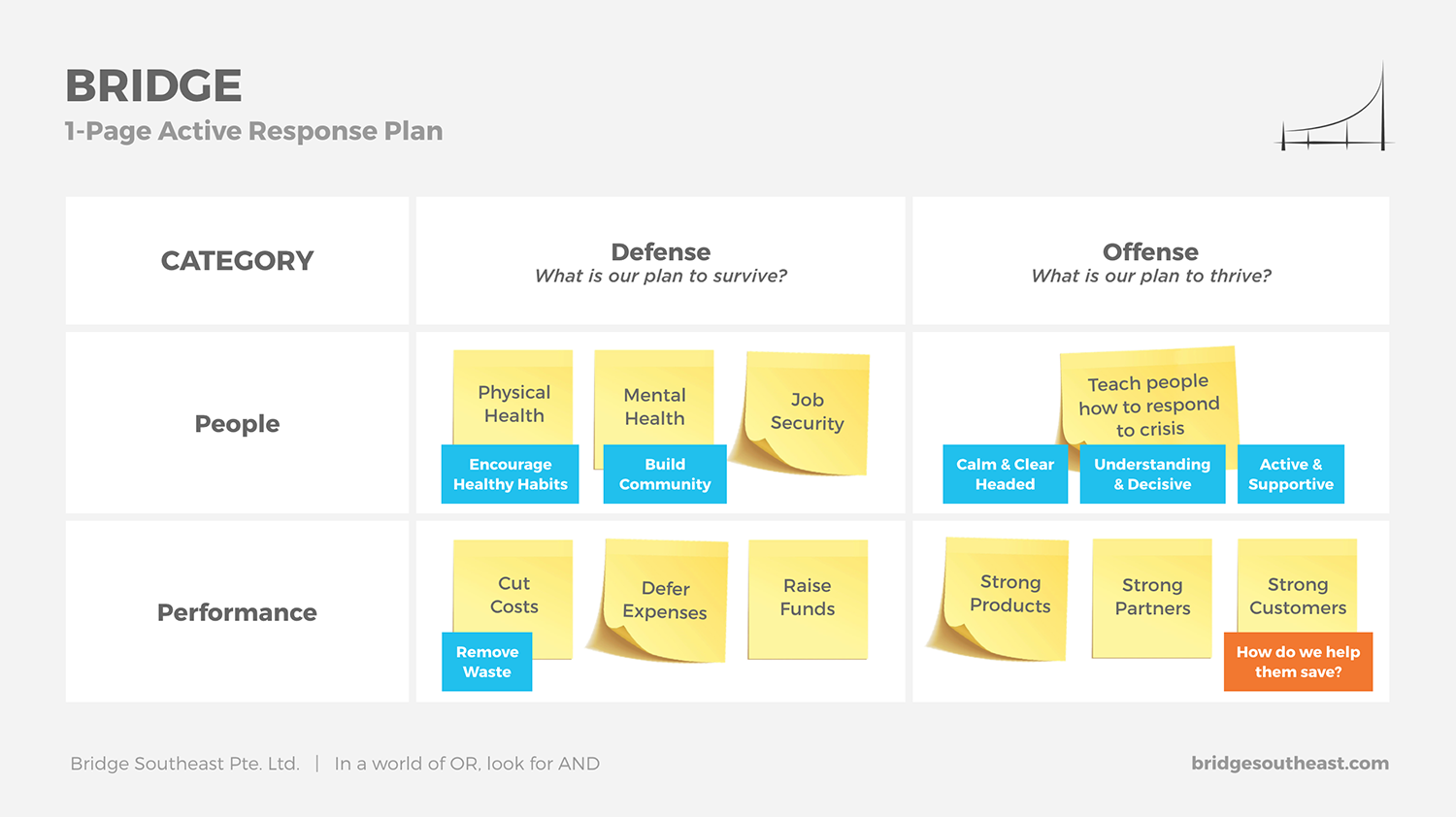
Summary
More than showing you what we’re doing, I want to share our approach. What you end up doing may be different from ours because your situation is different from ours. But I’d like to encourage you to keep one eye on the present and one eye on the future, connecting, or bridging, what is to what can be. There will always be challenges in business and in life, but they don’t have to stop us from progressing and growing. If you’re not sure how to proceed, follow these steps:
- Draw the 3×3 matrix on a piece of paper or white board
Category:
Defense Offense
People
Performance - Start with Defense: Think of what you need to DO in order to survive. This is a painful but necessary exercise.
- Move on to Offense: Think of what value creation you can start working on for your people and customers.
I hope this helps you as you formulate your own plans for addressing this once in a lifetime event.
Bonus: Thoughtfulness Beats Lavishness
One of the best things about being a startup and not having a lot of resources is that we have no option but to be very very creative about how we deal with our challenges. One thing I’ve learned throughout my career is that lack and necessity are two amazing ingredients for innovation. Because we can’t afford to be generous with what we don’t have, and we don’t have a lot of money, we focus on being as thoughtful as possible with the value we want to offer. I like what Eric Wong, COO of Bridge, shared with us in our huddle. He told us about how he spoke to his family about the financial impact the Coronavirus would have on them. His son is 4 years old and his daughter is 1. He remembered how his own parents explained to him and his siblings when they went through their own challenges in the past, teaching them and showing them how to address things head on as a family. This is something we want for all our own employees, that they may maximize this period of learning by treating it as an opportunity to mature, get stronger, and to face fear, not simply something ride out with hour after hour of Netflix.
While I wish we were in a position to absorb the shocks of life, the reality is that we aren’t, and that we are better off growing our people to be able to independently handle the shocks themselves. While we can’t give them the assurances large companies are making, we can provide them with something just as valuable, if not more so, which is an example of strong leadership during a time of crisis. I want them to come out of this remembering calm and clear-headedness, understanding and decisiveness, proactiveness and support from everyone in the company. While they may not appreciate these things right away, they will someday, because there will always be more challenges down the road.


